Disclosure: We may earn commissions if you purchase products after clicking on a link from our site.
Do you want to learn how to catch halibut? Halibuts are a favorite for anglers as it is a trophy fish because of their size and weight. It can be challenging to catch halibut because of its size, elusiveness, and being a bottom feeder. You can find halibut on the Pacific coast from Alaska to California. In this article, we share information and discuss how to catch halibut to help improve your chances of catching many halibuts.
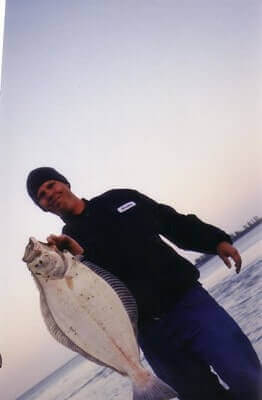
Table of Contents
- 1 How To Catch Halibut
- 2 1. Bottom Fishing
- 3 2. Trolling
- 4 3. Jigging
- 5 4. Drifting
- 6 Halibut Fishing Tackle
- 7 How To Catch Halibut From Shore
- 8 How To Catch Halibut In Alaska
- 9 How To Catch Halibut In The Surf
- 10 How To Catch Halibut in The Bay
- 11 How To Catch Halibut In California
- 12 How To Catch Halibut In San Diego
- 13 Best Baits For Halibut
- 14 Best Halibut Fishing Lures
- 15 Halibut Fishing Tips
- 16 The Bottom Line
How To Catch Halibut
Halibut fishing is not one of the most difficult fishing you will experience. Drop your line, with the bait on the hook, into the water and let it get to the bottom. After hitting the bottom, reel it up about 15 to 20 feet off the bottom. By bringing your line off the bottom a little bit, you are targeting the fish that are more active and perhaps hungry and looking for food.
When the fishing rod starts moving up and down, resist the urge to set the hook right away. Instead, wait until the tip is bent over and the fish has swallowed the bait. If you don’t wait for the halibut to take the bait in and you jerk up on the line, you will pull the bait and the hook out of its mouth. Then lift up the rod to set the hook in place. If you lift up the fishing rod too soon, it is possible that the hook could be pulled away from the fish’s mouth.
1. Bottom Fishing
Bottom fishing for halibut involves anchoring or drifting over known halibut grounds and presenting bait directly on or near the ocean floor where halibut is known to feed. Anglers typically use heavy tackle and large bait, such as whole fish or squid, to target these powerful fish.
The rig often includes a sliding sinker or a weighted jighead to keep the bait close to the bottom. Once a halibut takes the bait, anglers must set the hook firmly and then carefully reel in the fish, as halibut is known for their strong initial runs and stubborn resistance.
2. Trolling
Trolling for halibut involves slowly moving a boat through areas where halibut is likely to be found, dragging bait or lures behind the vessel at varying depths. Anglers use downriggers or weighted lines to control the depth of their presentation, ensuring that their bait or lures remain near the bottom where halibut is often found.
Common trolling baits for halibut include herring, squid, or artificial lures designed to mimic baitfish. This method allows anglers to cover a large area of water and locate actively feeding halibut, making it an effective technique, especially in deeper offshore waters.
3. Jigging
Jigging for halibut involves vertically jigging heavy metal jigs or soft plastic lures near the ocean floor to entice strikes from halibut. Anglers drop their jigs to the bottom and then rapidly lift and lower them through the water column to imitate the erratic movements of wounded baitfish.
This technique is particularly effective in areas with strong currents or when targeting halibut holding near underwater structures. Successful jigging requires precise rod control and the ability to feel subtle strikes, as halibut often hits the lure on the descent.
4. Drifting
Drifting for halibut involves allowing the boat to drift naturally with the current while presenting bait or lures along the seafloor. Anglers strategically position their baits or lures to cover productive areas where halibut are likely to be feeding. This method allows anglers to cover a wide range of depths and bottom structures, increasing the likelihood of encountering actively feeding halibut.
Drifting is particularly effective when fishing over expansive flats or along underwater ledges and drop-offs where halibut is known to congregate. Anglers must remain vigilant and regularly check their baits to ensure they are presented effectively during the drift.
Halibut Fishing Tackle
You can use a 7 to 8-foot medium heavy fishing rod with fast action that is rated for a 15- to 25-pound line. A 20 to 30-pound mono or 50 to 65-pound braided line will work. A Carolina rig or sinker-slider setup should work. Circle hooks 16/0 to 22/0 are the best for halibut.
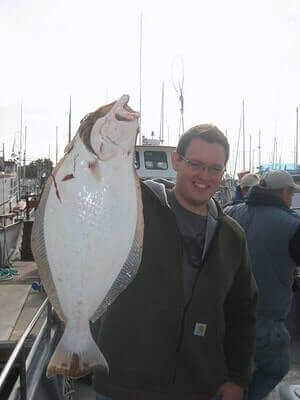
How To Catch Halibut From Shore
When you fish for halibut from the shore, look along the shore for structures like holes, troughs, kelp beds, deep pockets, and reefs. There is a saying among anglers, “find the structure, find the fish”. When you find these structures along the shore, watch to see which direction the current is heading as the halibut will be at the entry of these structures waiting for bait to be pushed in the direction of the currents.
When you locate the entry points of the structures from north to south, cast your bait accordingly to find the halibut. When you get a fish on your line, keep the line tight and do a slow and steady retrieve through the structures as you pay close attention to the edges of the structures.
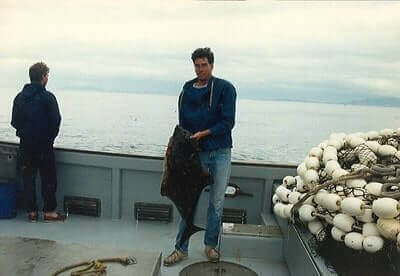
How To Catch Halibut In Alaska
When fishing for halibut in Alaska, most anglers will use a chum bag. Why? Because halibut uses scent, sight, and sound to find food. In shallow waters close to the coast, halibut will use sight and sound to find food. But in deeper waters, they rely on their sense of smell.
Anglers will anchor the boat at a spot they believe halibut are hanging around. A fish finder or sonar device is used to find these spots. The chum bag can have fish heads, gills, and leftovers after cleaning.
Halibut likes herring and anglers use it as bait when fishing for halibut. The fillets release more scent into the water which attracts more halibut than steaks. Salmon is another fish that can be used as bait when fishing for halibut. A combination of herring and salmon is a winning combination when fishing for halibut in Alaska.
When fishing for halibut, anchoring and remaining in one spot is very important. You must be patient when fishing for halibut as it takes some time to attract halibut with the scent of the bait and chumming takes time for the odor to permeate the waters.
After the chum has soaked in the water for some time, drop your bait into the water and release it slowly so that it doesn’t fall quickly to the bottom. Move the bait up and down a little to release more of the scent to attract halibut.
When fishing for halibut from a pier, look for structures like jetties, rocks, logs, and broken-down structures that halibut may use as cover when waiting in an ambush for prey. Live bait is the best when fishing for halibut but other bait will work as well.
Cast your bait so it sinks to the bottom and then slowly bring it back up. Halibut will play with your bait for a while. They will bite it, hold it in their mouths, and get a good feel for it before deciding to go for it. This is why you want to use circle hooks. Be patient and trust the process. Wait until the halibut takes the bait and dash off. When it runs off, the hook will set by itself.
How To Catch Halibut In The Surf
When fishing for halibut in the surf, look around structures like jetties, riptides, eddies, harbors, estuaries, troughs, and holes. kelp beds, river mouths, and reefs. Another area to look for halibut is where sand meets rocks. There will be fish in there and halibut will be preying on them. Open beaches with a rocky point close to them will also be a good area to fish for halibut.
Cast your bait or lures into these areas when fishing for halibut in the surf. Herring, salmon, jerkbaits, spoons, and soft plastics are some of the baits and lures that can be used when fishing for halibut in the surf.
How To Catch Halibut in The Bay
When fishing for halibut in the bay, look for halibut around reefs, rocks, mud, sand, and at the bottom. It will be at the bottom waiting to prey on herring. Trolling and drift fishing are fishing methods that are used when fishing for halibut in the bay.
Live bait works well when fishing for halibut in the bay area; however, lures can also be used to good effect. Smelt, mudsuckers, and shiner perch are baits that are often used when fishing for halibut.
How To Catch Halibut In California
When fishing for halibut in California, look for them near harbors, around jetties, estuaries, river mouths, and inside bays. Additionally, they can also be found near holes, kelp beds, and reefs. Cast your bait or lure close to these structures to catch halibut. Another area where you can find halibut is the area where rocks meet sand. Halibut waits in these areas to ambush bait.
How To Catch Halibut In San Diego
Halibut can be found on the sandy bottoms waiting in an ambush for prey. They can also be found near jetties, riptides, eddies, harbors, estuaries, troughs, holes, kelp beds, river mouths, and reefs. Live bait is the best bait when fishing for halibut in San Diego, although lures can also be used.
Bottom fishing, trolling, and drift fishing are some of the fishing methods used to catch halibut. A halibut rig will serve you well. When you feel a bite, slowly reel in the catch until you get it into the boat. Be prepared for a fight.
Best Baits For Halibut
1. Herring
Herring is a popular bait choice for halibut fishing due to its oily and aromatic nature, which attracts these bottom-dwelling predators. When rigged properly, herring can mimic the natural movement of baitfish, making it irresistible to hungry halibut.
Anglers often use whole or cut herring, rigging them onto circle hooks or jigheads and lowering them to the ocean floor where halibut typically feed. Additionally, herring can be used in conjunction with trolling, where it’s trolled behind the boat at varying depths to cover a wider area and entice halibut strikes.
Whether drifted, trolled, or presented on the bottom, herring effectively targets halibut, especially in areas where these flatfish are abundant. Its availability, scent, and lifelike movement make it a staple bait for anglers pursuing halibut in both shallow and deep waters.
2. Salmon
Salmon is a highly effective bait for halibut fishing, particularly in regions where salmon runs are abundant and halibut often feed on them. Whether fresh or frozen, salmon emits a strong scent that attracts halibut from a distance.
Anglers often use salmon heads, carcasses, or fillets as bait, either whole or cut into chunks to maximize scent dispersal in the water. The natural oils and fatty content of salmon make it particularly appealing to halibut, enticing them to strike. Salmon can be rigged onto circle hooks, jigheads, or halibut spreader bars and lowered to the ocean floor, where halibut typically resides.
Salmon can also be used in conjunction with trolling methods, where it’s trolled behind the boat to cover a larger area and increase the chances of attracting halibut. Overall, salmon is a versatile and effective bait choice for targeting halibut, offering anglers a reliable option for enticing these prized flatfish.
3. Squid
Squid is a popular and effective bait choice for targeting halibut. Its strong scent and natural movement in the water make it highly attractive to these bottom-dwelling predators. Anglers often use whole squid or squid strips, either fresh or frozen, as bait when fishing for halibut.
The texture and durability of squid allow it to withstand the rigors of bottom fishing, where it can be presented on various rigs such as spreader bars, sliding rigs, or jigheads. Additionally, squid can be enhanced with scents or attractants to further entice halibut to bite.
When fishing with squid, anglers typically lower their rigs to the ocean floor and jig or bounce them along the bottom to mimic the movements of live prey. Squid’s versatility, availability, and effectiveness in attracting halibut make it a go-to bait option for anglers targeting these prized flatfish.
4. Octopus
Octopus is an excellent bait choice for anglers targeting halibut. Its tough, rubbery texture and strong scent make it highly attractive to these bottom-dwelling predators. Anglers often use whole octopus or octopus tentacles as bait, either fresh or frozen.
Octopus can be presented on various rigs such as spreader bars, sliding rigs, or jigheads. Its durable nature allows it to withstand the rigors of bottom fishing and stay on the hook longer, increasing the chances of attracting halibut. Anglers typically lower their rigs to the ocean floor and jig or bounce them along the bottom to mimic the movements of live prey.
Octopus’s natural appearance and movement in the water make it a highly effective bait for enticing halibut bites. Additionally, octopus can be enhanced with scents or attractants to further increase its effectiveness. Overall, octopus is a versatile and reliable bait option for anglers targeting halibut.
5. Cod
Cod is a popular bait choice for anglers targeting halibut, particularly in regions where both species coexist. Fresh or frozen cod fillets, heads, or chunks are commonly used to attract halibut. Cod emits a strong scent that halibut finds irresistible, making it an effective bait for enticing bites.
Anglers often rig cod onto heavy-duty circle hooks using various methods such as bottom rigs, spreader bars, or sliding rigs. When fishing for halibut, anglers typically present the bait on or near the ocean floor, where halibut tends to feed.
Cod’s oily flesh and firm texture hold up well to the rigors of bottom fishing, ensuring that it remains intact and attractive to hungry halibut. Additionally, the natural appearance and scent of cod make it a reliable bait option for targeting these prized bottom-dwelling predators. Overall, cod is a versatile and effective bait choice for anglers seeking to hook into halibut.
6. Crab
Crab is a highly effective bait for targeting halibut, prized for its strong scent and natural appearance. Anglers often use various species of crab, including Dungeness crab, rock crab, and sand crab, to entice halibut. The tough outer shell and rich, meaty interior of crabs make them particularly enticing to halibut, which are known for their preference for bottom-dwelling prey.
Anglers typically rig crab baits onto heavy-duty hooks using methods such as bottom rigs, spreader bars, or sliding rigs, ensuring the bait remains secure and properly presented on the ocean floor. Whether using whole crabs, crab chunks, or crab legs, the scent and texture of crab make it irresistible to hungry halibut.
Additionally, crab baits can be enhanced with scent attractants or natural oils to further entice halibut to strike. Overall, crab is a top choice for anglers targeting halibut, offering both effectiveness and versatility in a variety of fishing situations.
7. Anchovies
Anchovies are a popular bait choice for targeting halibut due to their strong scent and natural appearance in the water. These small, oily fish are highly attractive to predatory species like halibut, which are drawn to the scent trail left by anchovies as they swim.
Anglers often use whole anchovies or anchovy fillets rigged on heavy-duty hooks, ensuring they remain securely attached to the fishing line. Anchovies can be fished both fresh or frozen, with some anglers opting to brine them beforehand to enhance their scent and durability.
When fishing with anchovies for halibut, anglers typically employ bottom fishing techniques, allowing the bait to sink to the ocean floor where halibut is known to feed. Additionally, anchovies can be used in combination with other baits or attractants to create a more enticing presentation. Overall, anchovies are a reliable and effective bait choice for anglers targeting halibut in a variety of fishing environments.
8. Mackerel
Mackerel is a favored bait among anglers targeting halibut due to its oily flesh and strong scent, which can attract these bottom-dwelling predators. Typically, anglers use whole mackerel or large chunks of filleted mackerel as bait, often rigging them on heavy-duty hooks to withstand the powerful bite of halibut.
Fresh mackerel is preferred, but frozen mackerel can also be effective when properly thawed and rigged. When fishing with mackerel for halibut, anglers often employ bottom fishing techniques, allowing the bait to rest on the ocean floor where halibut is known to lurk. Some anglers also opt to brine mackerel beforehand to enhance its scent and durability in the water. Overall, mackerel’s natural oils and scent make it a reliable bait choice for enticing halibut and increasing the chances of a successful catch.
9. Sardines
Sardines are a popular bait choice among anglers targeting halibut due to their oily flesh and strong scent, which can attract these predatory fish. Anglers often use whole sardines or chunks of filleted sardines as bait, rigging them on heavy-duty hooks to withstand the powerful bite of halibut. Fresh sardines are preferred, but frozen sardines can also be effective when properly thawed and rigged.
When fishing with sardines for halibut, anglers typically employ bottom fishing techniques, allowing the bait to rest on the ocean floor where halibut is known to feed. Some anglers may also opt to brine sardines beforehand to enhance their scent and durability in the water. Overall, sardines’ natural oils and strong aroma make them a reliable bait choice for enticing halibut and increasing the chances of a successful catch.
10. Lizardfish
Lizardfish can be an effective bait choice for targeting halibut, especially in regions where they are abundant. While not as commonly used as other baitfish species like herring or sardines, lizardfish can still attract halibut due to their availability and resemblance to natural prey.
Anglers often rig whole or cut lizardfish onto heavy-duty hooks, ensuring that the bait remains intact when presented to halibut. The strong scent and oily flesh of lizardfish can make them appealing to halibut, enticing them to strike.
When using lizardfish as bait for halibut, anglers typically employ bottom fishing techniques, allowing the bait to settle on the ocean floor where halibut is known to forage. While not as widely utilized as other bait options, lizardfish can still be a viable choice for anglers targeting halibut, particularly in areas where they are plentiful.

Best Halibut Fishing Lures
1. Swimbaits
Swimbaits are versatile lures that can be highly effective for targeting halibut, especially when fishing in deeper waters or along the ocean floor. These artificial baits mimic the appearance and swimming action of natural prey fish, making them irresistible to predatory species like halibut.
Anglers typically rig swimbaits on jig heads or weighted hooks to achieve the desired depth and presentation. The lifelike swimming motion of swimbaits, combined with their realistic appearance, can trigger aggressive strikes from halibut lurking in the depths.
Anglers often vary their retrieval speed and technique to imitate the erratic movements of injured baitfish, enticing halibut to strike. Swimbaits come in a variety of sizes, colors, and styles, allowing anglers to match the hatch or experiment with different presentations to find what works best in their fishing location. Whether cast and retrieved or bounced along the bottom, swimbaits can be a valuable addition to an angler’s arsenal when targeting halibut.
2. Berkley Gulp
Berkley Gulp baits are a popular choice among anglers targeting halibut due to their lifelike appearance and potent scent. These soft plastic baits are infused with natural flavors and scents that mimic the smell of real baitfish, enticing halibut to strike.
Berkley Gulp baits come in various shapes and sizes, including swimbaits, grubs, and shrimp imitations, offering anglers versatility in their presentation. The soft texture of these baits allows them to move naturally in the water, imitating the swimming action of live baitfish.
Anglers can rig Berkley Gulp baits on jig heads or weighted hooks and fish them at different depths, depending on the target depth of the halibut. Whether cast and retrieved or bounced along the ocean floor, Berkley Gulp baits can be effective in enticing halibut to bite. Additionally, their durability ensures that they can withstand multiple strikes from aggressive fish, making them a reliable option for anglers pursuing these prized flatfish.
3. Spoons
Spoons are effective lures for targeting halibut, especially when fishing in deeper waters or near the ocean floor. These metal lures mimic the shimmering flash of baitfish as they flutter and wobble through the water column, attracting the attention of predatory halibut.
Typically made from stainless steel or other durable metals, spoons are designed to imitate wounded or struggling baitfish, making them irresistible to hungry halibut. Anglers can vary their retrieve speed and depth to match the feeding preferences of the halibut, with slower retrieves often being more effective in enticing strikes.
Additionally, spoons can be rigged with a variety of trailers or teasers to enhance their attractiveness, such as soft plastic grubs or squid skirts. When casting spoons, anglers should aim to cover a wide area to locate active fish, and they can also be jigged vertically when fishing from a boat or kayak. Overall, spoons are versatile and productive lures for targeting halibut in a variety of fishing scenarios.
4. Plastics
Plastics, particularly soft plastic baits, are highly effective lures for targeting halibut in various fishing environments. These artificial lures come in a wide range of shapes, sizes, and colors, allowing anglers to mimic the appearance and movements of different baitfish and other prey species.
Common types of plastic lures used for halibut fishing include swimbaits, grubs, worms, and shad bodies. When rigged on jig heads or weighted swimbait hooks, plastics can be worked at different depths and retrieved at various speeds to entice strikes from halibut. The soft, lifelike action of plastic baits in the water makes them irresistible to predatory fish like halibut, and their durable construction ensures they can withstand multiple strikes and bites.
Plastics are particularly effective when fishing structure-rich areas such as rocky reefs, underwater ledges, and drop-offs where halibut are known to frequent. Anglers can experiment with different sizes, colors, and rigging techniques to find the most productive setup for targeting halibut in their local waters.
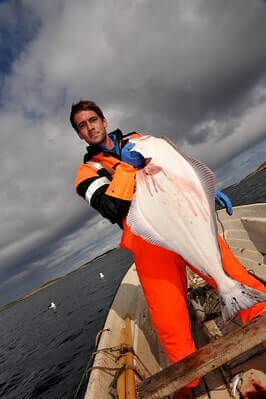
Halibut Fishing Tips
1. Keep your hooks sharp.
2. Be patient when fishing for halibut. Halibut strikes take time. Allow some time for the halibut to eat some of the bait before you attempt to set the hook.

3. Halibut uses scent, sight, and sound to find food.
4. Use chumming to attract halibut in your direction.
5. Herring is one of the most popular baits for halibut.

6. A herring fillet will produce more scents in the water than a whole herring or steaks and will produce more aggressive bites.
7. Salmon is also a good bait for halibut.
8. Use circle hooks when fishing for halibut.
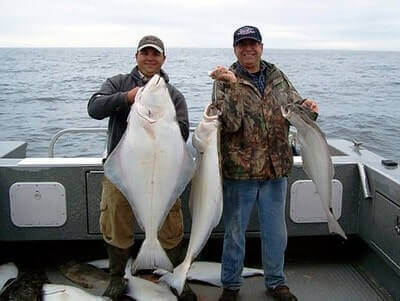
9. Multiple jigs can cause tangles if the area you are fishing has a current. Just run a single jig.
10. Use whole salmon heads as bait if you want to get big halibuts.
11. Although halibut are bottom feeders, go after the ones that have moved off the bottom to feed. They will be more active and receptive as they are hunting for food.
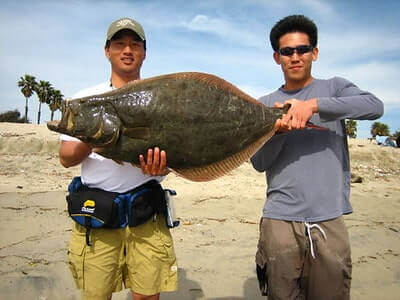
12. Use polarized sunglasses to help you avoid the sun’s glare and see what is in the water.
13. Go with a strong and lightweight fishing line.
14. Lower your line to the bottom and then reel up about 15 to 20 feet off the floor.
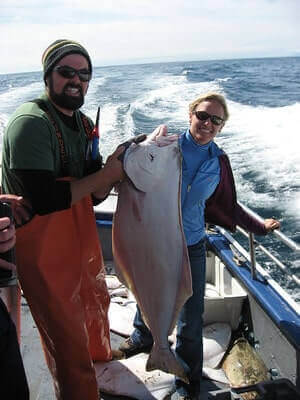
15. Don’t start pulling to set the hook once you see little action on the rod. Instead, wait until the tip is bent over and the fish has swallowed the bait. Then lift up the fishing rod to set the hook in.
16. If after casting a good number of times you get no action, consider moving to another area.
17. When a halibut is hooked on the line, gradually pull the line up with control. Wind and lower the rod and then pull again. Carefully and methodically pull and bring the halibut up close to the water’s surface.
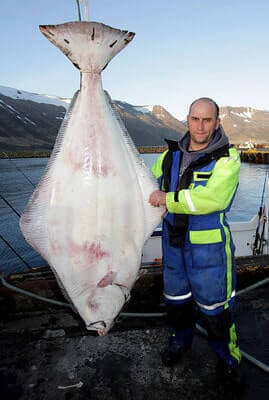
18. When you have a spooked halibut on your line, don’t try to fight it or pull it closer. Instead, let it run free for some time to calm down. You don’t want to lose the hook or break the line. After a short time, slowly try to bring it up again.
19. Allow the halibut to get weakened a bit by keeping its head underwater for some time before bringing it onboard. Halibut can cause serious injury to individuals who are not very careful.
20. Find out the direction of the current. Most halibut will approach from downstream going upstream.
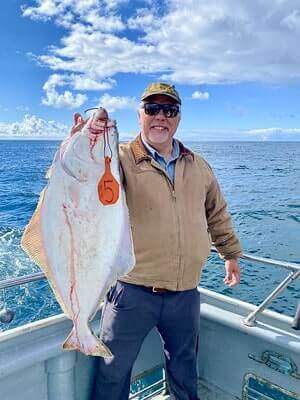
21. You can fish for halibut near structures like wrecks, jetties, sea walls, reefs, kelp beds, and breakwaters.
22. Always keep your baits or lures moving when fishing for halibut.
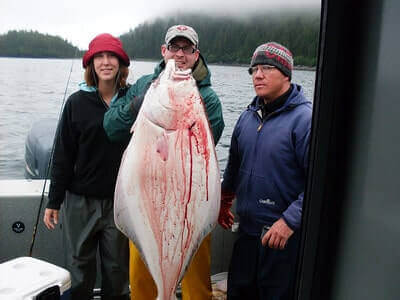
The Bottom Line
Halibuts grow to be very large and are bottom feeders. They can be challenging to catch due to their size, temperament, and bottom-feeding behavior. In this article, we discussed the behaviors of halibuts and shared tips, and techniques to catch halibut. We hope that you will find the information helpful and improve your chances of catching more halibut.
If you are interested in catching corbina, jack crevalle, and cobia, then read how to catch California corbina, how to catch jack crevalle, and how to catch cobia.